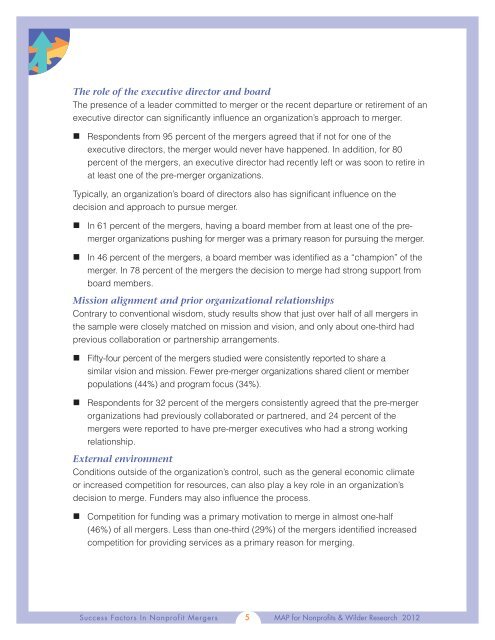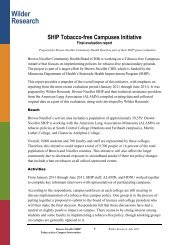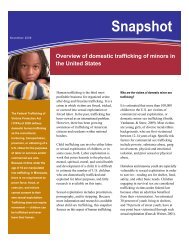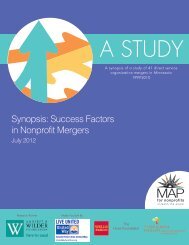Success Factors in Nonprofit Mergers - Minnesota Council of ...
Success Factors in Nonprofit Mergers - Minnesota Council of ...
Success Factors in Nonprofit Mergers - Minnesota Council of ...
Create successful ePaper yourself
Turn your PDF publications into a flip-book with our unique Google optimized e-Paper software.
<strong>Success</strong> <strong>Factors</strong><br />
<strong>in</strong> nonpr<strong>of</strong>it mergers<br />
<strong>Factors</strong> proven to make nonpr<strong>of</strong>its mergers more likely to succeed<br />
The role <strong>of</strong> the executive director and board<br />
The presence <strong>of</strong> a leader committed to merger or the recent departure or retirement <strong>of</strong> an<br />
executive director can significantly <strong>in</strong>fluence an organization’s approach to merger.<br />
• Respondents from 95 percent <strong>of</strong> the mergers agreed that if not for one <strong>of</strong> the<br />
executive directors, the merger would never have happened. In addition, for 80<br />
percent <strong>of</strong> the mergers, an executive director had recently left or was soon to retire <strong>in</strong><br />
at least one <strong>of</strong> the pre-merger organizations.<br />
Typically, an organization’s board <strong>of</strong> directors also has significant <strong>in</strong>fluence on the<br />
decision and approach to pursue merger.<br />
• In 61 percent <strong>of</strong> the mergers, hav<strong>in</strong>g a board member from at least one <strong>of</strong> the premerger<br />
organizations push<strong>in</strong>g for merger was a primary reason for pursu<strong>in</strong>g the merger.<br />
• In 46 percent <strong>of</strong> the mergers, a board member was identified as a “champion” <strong>of</strong> the<br />
merger. In 78 percent <strong>of</strong> the mergers the decision to merge had strong support from<br />
board members.<br />
Mission alignment and prior organizational relationships<br />
Contrary to conventional wisdom, study results show that just over half <strong>of</strong> all mergers <strong>in</strong><br />
the sample were closely matched on mission and vision, and only about one-third had<br />
previous collaboration or partnership arrangements.<br />
• Fifty-four percent <strong>of</strong> the mergers studied were consistently reported to share a<br />
similar vision and mission. Fewer pre-merger organizations shared client or member<br />
populations (44%) and program focus (34%).<br />
• Respondents for 32 percent <strong>of</strong> the mergers consistently agreed that the pre-merger<br />
organizations had previously collaborated or partnered, and 24 percent <strong>of</strong> the<br />
mergers were reported to have pre-merger executives who had a strong work<strong>in</strong>g<br />
relationship.<br />
External environment<br />
Conditions outside <strong>of</strong> the organization’s control, such as the general economic climate<br />
or <strong>in</strong>creased competition for resources, can also play a key role <strong>in</strong> an organization’s<br />
decision to merge. Funders may also <strong>in</strong>fluence the process.<br />
• Competition for fund<strong>in</strong>g was a primary motivation to merge <strong>in</strong> almost one-half<br />
(46%) <strong>of</strong> all mergers. Less than one-third (29%) <strong>of</strong> the mergers identified <strong>in</strong>creased<br />
competition for provid<strong>in</strong>g services as a primary reason for merg<strong>in</strong>g.<br />
<strong>Success</strong> <strong>Factors</strong> In <strong>Nonpr<strong>of</strong>it</strong> <strong>Mergers</strong> 5 MAP for <strong>Nonpr<strong>of</strong>it</strong>s & Wilder Research 2012

















